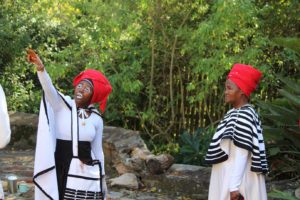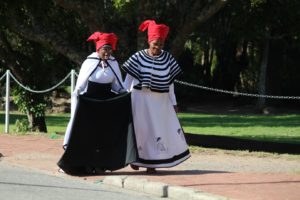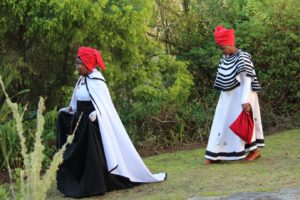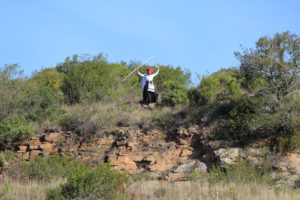
For me performing is an extension of my art production, I get to channel suppressed traits like confidence, I get to speak and heal from issues that bother me, but most importantly physically engaging the space takes the work to another dimension. So it makes sense to physically connect with the audience because the issues I engage aren’t translated into an art object since I am mostly interested in invoking emotion. So what better way to be present and illustrate, my journey of learning which has been an uphill experience, than to use my body, voice, and presence?
Barnabas Ticha Muvhuti in conversation with the South African artist Viwe Madinda
Viwe Madinda: Kwathi Kaloku Ngatsomi
Focusing on Viwe Madinda’s Kwathi Kaloku Ngatsomi, a live art performance staged under the Arts Lounge Program, during South Africa’s 2019 National Arts Festival in Makhanda, this conversation dwells on the significance of the performance. It explores the key symbolic gestures the artist and her mother employed to convey the underlying message. In the aftermath of the performance, Barnabas Ticha Muvhuti sat down with Viwe Madinda to discuss and unpack some of the key moments in the work. What follows is an edited transcript of the conversation which took place at the Arts Lounge at the Arts of Africa and Global Souths Research Program at Rhodes University.
Barnabas Ticha Muvhuti (BTM): Can you start by breaking down the Kwati Kaloku Ngatsomi concept?
Viwe Madinda (VM): At first, the title was for the body of work that I am working on for my grad exhibition. So I decided to use that title for the performance because it leads the audience to the actual exhibition venue, which based on the story of Zintombi Zam Zenani (the title of the exhibition). Kwathi Kaloku Ngatsomi is a phrase used in Xhosa storytelling as an introduction to a folklore tale. So the performance functions as an introduction to my current body of work which explores themes of spirituality, culture, and decoloniality through my experiences.

BTM: Where did this idea of performing the journey of your life come from? What does walking symbolize?
VM: For my graduation exhibition and as an emerging artist the aim is to engage and understand my own experience, in the bigger picture of using my practice to make some sort of contribution to scholarship and society. One of the big current social issues is mental health and having lived with depression and anxiety I wanted to use the platform to reflect on the trials and tribulations I have faced in the course of my fine arts degree. For me performing is an extension of my art production, I get to channel suppressed traits like confidence, I get to speak and heal from issues that bother me, but most importantly physically engaging the space takes the work to another dimension. So it makes sense to physically connect with the audience because the issues I engage aren’t translated into an art object since I am mostly interested in invoking emotion. So what better way to be present and illustrate, my journey of learning which has been an uphill experience, than to use my body, voice, and presence?
*
BTM: Please tell me about the institutions you have come through and how they shaped you.
VM: Coming to university accorded me the opportunity to reflect and learn about myself. Having been brought up in the church influenced a restricted perception of the world and the way I looked and felt about myself. With my educational background, I, unfortunately, faced the injustice of being compelled to assimilate to white cultural values and mask my black identity, since I went to a Model C school. Growing up in such surroundings impacted my self-esteem, mindset, and identity. Coming to university was a change I wasn’t prepared for because I was now in a space that required me to be a black agentic woman, and I didn’t know how to. And this is because I only learned of my oppressed intersecting identities at age 22 and being away from the church, family, and friends caused a mental breakdown for what seemed like a never-ending period of an identity crisis. This is the result of always being told who I was and how to behave, so when I came to university it was an eye-opening experience to the comfort I had set up in my struggle of being a black body living under the system.
*
BTM: I think its Frantz Fanon who talks of the colonized mimicking the colonizer who despises them.

VM: Exactly! I always had to conform to their standards. For instance, being umXhosa and Christian meant I had to let go of my cultural identity and not take part in any Xhosa traditional practices, and that took away from my identity. Spiritually it suppressed the power passed down to me from my forefathers and made me see African spirituality as demonic. If I may add, I have a gift of seeing and at home I have always been known to be umntana wesinxobo, which is known as a caul bearer in English. So, I grew to decide that I’d be a prophet instead of being iGqirha and had prepared myself to turn down the calling when it is my time.
Through this body of work, I am engaging decoloniality and I’m talking about the milestones I have reached with regards to understanding my sexuality, spirituality, and self. The work is based on where I am coming from, this journey that I have travelled and where I am going to.

BTM: On your journey, you headed in the direction of the 1820 Settlers Monument, which is a colonial feature towering over the Makhanda landscape. Please enlighten me on the significance of that?
VM: The monument is on a beautiful landscape of the city. However, it is not accessible to all the people of Makhanda. Its position somehow polices movement and excludes certain black bodies. Going to the monument is a step I intend to expand on. I would like to take the community I grew up in, from Joza Township, and walk with them up to that space as a way of opening up the privileged spaces I have managed to access as a black body. It is also symbolic of where I am going, which is graduation. So, it is a symbolic combination of deconstructing boundaries and using my practice to take everything that I have learned and making a contribution at home. You will realize that I took a turn and headed to the mountainside in front of Fort Selwyn and its canons. Conscious of the history of that place the idea of inserting my presence as a Xhosa descendant functions as subversion to the celebration of that place. Lastly, the mountain top signifies the end of my undergraduate journey, as my graduation exhibition venue will be in the 1820 Settlers Monument, and that is also where the graduation ceremony will take place in 2020. Conceptually the top of the mountain illustrates a point of triumph and an advantageous view of perception on my journey and where I am going next.
*
BTM: It is also a strategic site from where you have a nice view of the rest of Makhanda
VM: Yes, which also symbolically means gaining access to privileged spaces.
*
BTM: I would like to think the clothes you were wearing are not just ordinary traditional garments. They hold special meanings to you. Please tell me more about them.
VM: I always wear a costume for my performances, and this is because my first career choice was the fashion industry. In the past year, I received a revelation beyond the physical. In the course of that, I was introduced to three guides that reside within me which I represent in different ways in my work, and the colour is one of them. The colours being red, black and white. They mark how each guide is positioned in each performance. Red is for the first guide I met. Mkhungi, the intercessor, is the guide that engages the ritualistic aspects of my performances. She prays and meditates. That spiritual journey led me to the other guide, Nkwenkwezi who is represented by white. She is the star and the light of the journey. She gives direction and perspective. In that performance, she also provided the compass. Alternatively, she would also be represented by candles. Having perspective enabled me to meet the other guide uGokra who is the activist in me. She is represented by the colour black. Through her, I can engage and address the challenges I face in academia, art, and society in general. Nkwenkwezi shed light on all the injustices that I have faced as a black woman. When I am performing the guide that would be at the forefront is going to be the dominant colour, and as mentioned earlier each guide takes a position on my body. In Kwathi Kaluku Ngatsomi I wore a white cap. That was Nkwenkwezi who was leading. And this is because the performance was about journeying somewhere, and she was giving directions and light. I wore a red doek and this means Mkhungi was present psychically. And a black skirt meaning uGokrakazi was present physically and actively.

BTM: At certain spots your mother would point in a certain direction. You would do the same too. Would you please explain the significance of that?
VM: In the performance we were walking towards two destinations, one being the Arts Lounge. So, in finding our first location we used the sun to lead us. When we got to the junction of the Arts Lounge, Nkwenkwezi looked at the position of the sun and at that spot drew a campus. Then my mother looked at the campus and pointed in the direction that we were supposed to go. This performative gesturing symbolized how my mother has always played a pivotal role in my work and practice. She is my guide. And in my academic work, she edits my Xhosa writing and helps with refining some of my ideas. I am not conversant with some of the cultural aspects I engage in my work. So, she gives me direction since she knows the Xhosa culture. If she does not know something she always knows who else to go to.

BTM: At Gunfire Hill we saw you pointing back where you had come from. What did that mean?
VM: I come from eJoza which is to the east. The entrance to Rhodes University when coming to register as a student is in the same direction. So, walking up Lucas Avenue to the mountainside symbolized the beginning and end of my four-year journey. Pointing back to the east is my aspiration to go back home with all the knowledge I’ve gathered and contribute by sharing that knowledge. And in that, I believe I must know myself to be able to make a positive impact on other people. So symbolically, reaching the top of the mountain also enacts my battle to fight for mental health which is important if I want to inspire and impact the youth of Joza.
*
BTM: The audience had to stop at the base of Gunfire Hill. Why did they have to look from a distance?
VM: Some paths are meant to be walked alone and coming to university was that path for me. At the end of the year, the audience will come to my exhibition and see a presentation of my work. People never see the process of producing a body of work. Walking up alone symbolized that, from my first ever practical and theoretical assessments which have led to this final presentation which is my graduate exhibition.

BTM: Your mother was with you for the greater part of the performance. Do you consider that a collaboration?
VM: Indeed, I consider that a collaboration. She is an artist and a writer in her own right. If I were to work with a fellow art student, I would call it a collaboration, why not with my mother? I think it is fair to call it a collaboration. She plays a crucial role in my life. I would rather have her with me than have her lurking in the background. She is a Xhosa-language teacher by profession. Growing up, I never got the opportunity to immerse myself in the language because we were not allowed to speak it at school. As such, my Xhosa is not that good. Having her has been very helpful because she edits my work and offers perspective on what I am not sure about. In the Xhosa language and customs, there are a lot of things I am still to learn. If I may add, costume-wise, she discovered a new hobby for herself, and started making clothes for herself last year. So, I design my costumes and her skill and touch create them to my vision.

BTM: I hardly could hear you speaking during the performance. Were you just silent?
VM: We weren’t silent. We were reciting a prayer, Psalm 23 “Uyehova ngumelusi wam” – “the Lord is my shepherd”. This is the prayer I grew up reciting before leaving the house. It became a tradition to recite it for protection, for the road to wherever we were going. It is only this year that I learned to recite the prayer in my language which has also shifted it to be more meaningful and relatable. This prayer is also sentimental because it was my late father’s favourite scripture.
*
BTM: You also walked past the Provost Café, which was a prison for black people.
VM: The significance of walking past the old jail toward a colonial fort is something that fell into place as I was planning the performance. The location of the performance links many historical sites.
